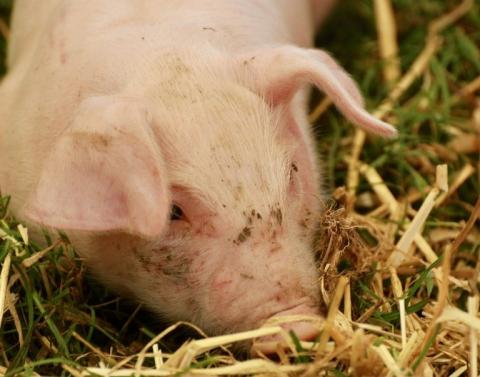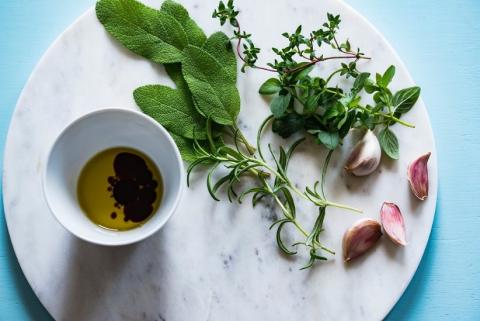8 November 2019
Dr Cate Williams: IBERS, Aberystwyth University.
- Antibiotic growth promoters were banned in the EU in 2006 which has resulted in renewed interest in alternative, novel solutions to improving performance, efficiency and animal health.
- Essential oils from herbs have been investigated as one such alternative, some studies suggest they can boost live weight gains and increase the shelf life of the meat.
- Many studies have struggled to replicate these results and findings are too inconsistent to base any animal management recommendations upon.
Introduction
The Welsh pig sector is relatively small, with just 23,000 pigs living in Wales compared to around 9,300,000 sheep and 1,000,000 cattle. Nevertheless, pigs are highly productive meat producers and are the most popular farmed species across the globe. As opportunistic omnivores (animals that given the chance, will consume meat and vegetables), pigs are flexible in terms of nutrition and by virtue are highly adaptable to different environments – be that in an intensive commercial unit or an extensive free-range system. However, in order to achieve optimum productive performance, the correct nutrients must be delivered at the correct time, as is the case with all farmed animals. To maximise growth, many producers in the past have used antibiotic growth promoters, however, due to a dangerous surge in antibiotic resistance their use in the EU was banned in 2006. This has prompted exploration of alternative, novel compounds which may improve herd health whilst also maximising growth and productivity in general. One potential solution currently being explored is the application of herbs in the pig’s diet.
A brief overview of pig nutrition
Like all livestock, pigs need a number of essential nutrients for four key purposes: bodily maintenance, growth, reproduction and lactation. The National Research Council (NRC) published ‘The nutrient requirements of swine’ in 2012, which provides comprehensive information about the nutrition of pigs under many different circumstances.
In general, pigs require carbohydrates, fats, protein, vitamins and minerals in their diet, the proportions of which differ somewhat from herbivorous ruminants (cattle, sheep and goats). The energy content of a feed is extremely important and heavily influences the amount of feed a pig will eat if offered ad-lib. Energy requirements depend on the weight of the pig, its genetic potential for tissue growth or milk production and its environment. The best method of increasing dietary energy content is through the inclusion of fats which increase efficiency and speed of weight gain but may also result in increased carcass fat. Protein (consisting of amino acids) is vital for growth, maintenance and reproduction. Of the 22 amino acids, 10 are essential, meaning that the pig is unable to produce them itself and must, therefore, receive them in the diet. Lysine is the amino acid in shortest supply for pigs, followed by tryptophan and threonine, so it is important that care is taken to provide these in adequate quantities to achieve optimum performance.
Corn is the principal grain in most swine diets but is consistently deficient in lysine and tryptophan. Other grains, such as sorghum, barley, and wheat are low in lysine and threonine. Deficiencies may be combatted by combining soybean meal with cereal grains into a complete diet. In a similar way to amino acids, some fatty acids are considered ‘essential’, for example, linoleic acid is considered to be of the most importance as it may be used as a building block for other limited fatty acids. Requirements are often met by oil from corn in the diet which is a rich source of linoleic acid. Vitamin and mineral requirements are also listed in NRC’s ‘The nutrient requirements of swine’ in considerable detail, as requirements fluctuate depending on many factors. Balancing vitamins and minerals in the diet is important, as deficiencies can lead to a whole host of problems such as rickets, anaemia, slow or inefficient growth and poor reproductive performance.
Herbs & essential oils
Oregano
Oregano (Origanum vulgare) is a common herb from the mint family, it is popular in cooking but its essential oil (oregano essential oil – OEO) has also been used in folk medicine for centuries, despite a lack of clinical evidence for its efficacy.
As mentioned previously, there exists a somewhat contradictory body of evidence that supplementation with OEO results in reduced lipid oxidation in the meat which in turn leads to slower deterioration of meat quality during storage. It is hypothesised that this effect is due to its active ingredients thymol and carvacrol which can protect lipids from oxidative damage, however, the exact mechanism is yet to be confirmed. Table 1 has collated the available studies for the inclusion of OEO in the diet. The information covers studies testing oregano oil in isolation, as many studies use several essential oils together, as herbal blends and in conjunction with other dietary parameters such as a low protein or an amino acid balanced diet. Often the inclusion rate of OEO differs between studies and it is worth noting that some studies only give the dosage in ppm and not mg/kg. As such, it may be difficult to accurately attribute any changes that are observed and to compare the studies to one another.
Table 1: A compilation of scientific studies investigating the effect of dietary supplementation with OEO on meat qualities and lipid oxidation. Dosage of OEO and age of pig used is also included.
|
Study |
OEO dosage (mg/kg) |
Stage of production |
Result |
|
250 |
Nursery pigs (barrows & gilts) |
No effects. |
|
|
500 |
Finisher pigs |
Non-significant reduction in lipid oxidation. No effects on other parameters |
|
|
250 |
Barrows & gilts (50:50) |
No effects. |
|
|
(ppm) 1000 2000 3000 |
Finisher pigs |
Non-significant reduction in lipid oxidation at 1000 ppm. No effects on other parameters. |
|
|
250 |
Finisher pigs |
Supplemented with vitamin E. All effects were significant: Higher average daily gain, hot carcass weight and dressing percentage, lower drip loss values and lipid oxidation. |
|
|
250 |
Growing-finishing pigs |
Improved oxidative stability and sensory characteristics, lowered lipid oxidation and drip loss. |
|
|
250 |
Growing-finishing pigs |
In combination with a low protein diet. Significantly reduced lipid oxidation and higher levels of monounsaturated fatty acids. |
|
|
(ppm) 1000 2000 3000 |
Finisher pigs |
Significant effect on carcass length and width (1,000 & 2,000), Higher loin yield and overall acceptability at 2,000 ppm. |
Studies suggest that OEO does not change the colour of pork but may improve the colour intensity of lamb and the luminosity of beef. Once again, mixed results are available which suggest that the inclusion of OEO improves overall acceptability of pork – e.g. tenderness, juiciness and flavour, although many studies show little or no effect and are mostly non-significant. A common concern when supplementing diets with volatile compounds that have strong aromas or flavours is meat or milk taint. However, there is no scientific evidence of this phenomena for OEO, instead, trials have reported better acceptability.
Immunity & anti-microbial effects
Essential oils are known to have natural anti-microbial properties which may seem a welcome alternative to antibiotic use. However, a plethora of issues accompany their use, for example, very high concentrations are needed to obtain antimicrobial effects, making their application expensive and impractical. Addition to the diet also reduces feed palatability (particularly at the concentrations needed to produce an effect) and there are issues with regards their potential toxic effects and regulatory concerns.
The two active ingredients of OEO, thymol and carvacrol work by weakening and damaging the bacterial cell walls. They show action against gram-positive and negative bacteria, fungi and yeasts, and in particular are effective against Salmonella sp. and E. coli sp. However, the active ingredients are almost fully absorbed in the stomach, so to ensure delivery to the hindgut (where they are most needed), they must be protected.. Considering the previously mentioned difficulties, the antimicrobial effects of essential oils might be better placed as a ‘green’ preservative to prevent food spoilage.
In terms of the effect that essential oils may have on the immune response, the evidence is mixed and difficult to interpret. Some studies show that a cocktail of herbal essential oils (EOs) improved many immune functions, however, this makes it impossible to attribute any effect to a single oil. Other studies have failed to replicate the success, finding no difference in the immune response after supplementation. For example, a 2011 study added 250 mg/kg OEO to the diet of sows during gestation and lactation but found no improvements to the immune response of her piglets. On the contrary, a more recent, 2015 study found that just 15 mg/kg of OEO improved the performance of the sow’s piglets by reducing the oxidative stress experienced by sows during gestation and lactation.
Artificial anti-oxidants are often used in pig feed, despite a lack of evidence for their efficacy. In an effort to deliver a better and more reliable alternative, scientific research has trialled the anti-oxidative effects of essential oils. Several laboratory studies have found that supplementation with OEO suppressed pathways that produce damage and increased production of antioxidant enzymes. Should the results of laboratory investigations carry over when OEO is applied to the animal, this could be a promising method for reducing oxidative damage resulting in improved milk production, reproductive performance and longevity of sows.
Inconsistencies are likely due to a number of factors, such as variable concentration of active components in the tested EO products or their stability in feed and/or in the digestive tract. Similarly, experiments using grower-finisher pigs have been inconsistent, with many studies reporting that the beneficial effects observed at the grower stage diminished during finishing. It is hypothesised that this is due to the older pig’s more developed digestive system, immunity and resistance to intestinal disorders. Such feedback suggests that the prime target for EOs may be in the nursery or grower phase and that to produce consistent results the stability of compounds need to be tested.
Summary
As yet, herbal extracts and essential oils are not backed up by enough consistent and comprehensive evidence to be recommended for use in animal nutrition. Whilst some promising results have been shown, these are mostly balanced by studies which could not reproduce the effects. It is essential that any changes in diet, or otherwise, in animal production are backed up by reliable scientific evidence and also by regulatory bodies to ensure safety. It is also important that investment in new products results in a return for the farmer, and as yet, this cannot be guaranteed through the use of herbal essential oils. Perhaps the take-home message here is to watch this space, because further research to prove or disprove the effects of essential oils will certainly be carried out and translated into the industry.


